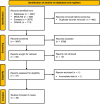Airway management in patients living with obesity: best practice recommendations from the Society for Obesity and Bariatric Anaesthesia: Endorsed by the All Wales Airway Group, Scottish Airway Group and Difficult Airway Society
- PMID: 40468902
- PMCID: PMC12351209
- DOI: 10.1111/anae.16647
Airway management in patients living with obesity: best practice recommendations from the Society for Obesity and Bariatric Anaesthesia: Endorsed by the All Wales Airway Group, Scottish Airway Group and Difficult Airway Society
Abstract
Introduction: Patients living with obesity present specific challenges for airway management. They have been overrepresented repeatedly in studies looking at complications associated with airway management. Whilst generic airway guidelines offer assistance, there are no evidence-based guidelines specific to this group of patients to support safe and effective airway management.
Methods: An expert multidisciplinary working party was convened on behalf of the Society of Obesity and Bariatric Anaesthesia to conduct this work. A systematic review was performed and was followed by a three-round Delphi process.
Results: Forty-three recommendations are made which cover a number of key areas of practice including: pre-assessment; planning; peroxygenation; tracheal intubation; supraglottic airway devices; tracheal extubation; training; and organisational responsibilities.
Discussion: It is hoped the recommendations made will improve the safety and efficacy of airway management in patients living with obesity. They are not intended to replace current airway management guidelines.
Keywords: airway; guidelines; obesity; tracheal intubation.
Plain language summary
People who are very overweight (obese) can have special problems when doctors need to help them breathe during surgery or emergencies. These problems happen more often in people with obesity than in others. There are general guidelines to help doctors, but there aren't any special guidelines just for people with obesity. A group of experts from different areas came together to help fix this problem. They looked at lots of research and then worked together through a process called Delphi (which means they asked for expert opinions in three rounds) to make a set of suggestions. The team made 43 suggestions. These suggestions cover important parts of helping people breathe safely, like: checking the person before surgery; making a plan; giving oxygen; putting in and taking out breathing tubes; using special breathing masks; training doctors and nurses; and making sure hospitals have the right processes. The team hopes these ideas will help doctors and nurses keep people with obesity safer when they need help with breathing.
© 2025 The Author(s). Anaesthesia published by John Wiley & Sons Ltd on behalf of Association of Anaesthetists.
References
-
- UK Government Office for Health Improvement and Disparities . Obesity Profile: short statistical commentary May 2024. 2024. https://www.gov.uk/government/statistics/update‐to‐the‐obesity‐profile‐o... (accessed 04/02/2025).
-
- Royal College of Anaesthetists , Difficult Airway Society . NAP4: Major Complications of Airway Management in the United Kingdom. 2011. https://www.rcoa.ac.uk/research/research‐projects/national‐audit‐project... (accessed 02/05/2025).
Publication types
MeSH terms
LinkOut - more resources
Full Text Sources
Medical


